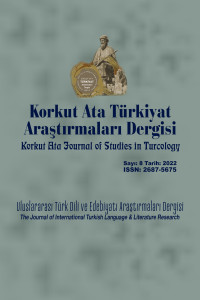Bin Hüzünlü Haz’da Yapıbozum ve Üstkurmaca
Bu makalede Türkiye’de postmodern edebiyatın temel metinlerinden biri olarak kabul edilen Hasan Ali Toptaş’ın Bin Hüzünlü Haz romanının başta “suç ve ceza” olmak üzere “dil ve gerçeklik”, “kelime ve cümle”, “hayat ve oyun” gibi kavram yapıları ve ikili karşıtlıkları arasındaki nedensel veya hiyerarşik ilişki ağını belirsizleştirerek yapıbozuma uğratması ve metnin sürekli kendi metinselliğine dikkat çekerek okuru semantik ve varoluşsal bir kararsızlıkta bırakan üstkurmaca karakterinin üzerinde durulur. Türk romanında üstkurmaca anlatıların yükselişi ile Avrupa edebî eleştiri kültüründe yazar nosyonunun farklı açılardan sorunsallaştırılması arasında belirli ilişkisellikler vardır. Yazar nosyonu yapısalcı ve post-yapısalcı edebiyat teorilerinde yeniden formüle edildiğinde metin karşısında okura bir açık alan vaat edilir. Buna karşılık çağdaş edebî metinlerin teknik veya türsel belirlenme süreçleri doğrudan veya dolaylı olarak hâlâ yazarı metnin yorumlanışında otorite olarak almayı sürdürür. Bin Hüzünlü Haz’zın gerçekleştirdiği yapıbozum sayesinde okuru metnin oluşumundan, dolayısıyla anlamından mesul kılarak poetik özgünlüğün müşterekliğe ve diyaloğa dayalı yapısını gösterdiği ileri sürülür. Böylece yazar-sonrası çağdaş edebiyat teorilerinde dahi hâlâ tutarlı söylemini üretememiş eleştiri/okur ve edebî metin arasındaki diyalojik ilişki, niyet (intention) kavramına dair eleştirel tutumla sağlanabilir.
Anahtar Kelimeler:
Bin Hüzünlü Haz, yapıbozum, üstkurmaca, orijinallik, diyalog, okur.
Deconstruction and Metafiction in A Thousand Gloomy Pleasures
This article examines how Hasan Ali Toptaş’s novel A Thousand Gloomy Pleasures deconstructs reality and constantly draws attention to its own textuality by obscuring the network of causal and hierarchical relations between conceptual structures and binary oppositions such as “crime and punishment”, “language and reality”, “word and sentence”, “life and play”. Additionally, this article emphasizes the metafictional character of Topbaş’s text, which leaves the reader in a semantic and existential uncertainty. There are certain correlations between the rise of metafictional narratives in the Turkish novel and the problematization of the notion of author from different perspectives in European literary criticism. When the notion of the author is reformulated in structuralist and post-structuralist literary theories, the reader is promised an open space in the face of the text. In contrast, the processes of technical or genre determination of contemporary literary texts still directly or indirectly take the author as the authority in the interpretation of the text. Through its deconstruction, it is argued that, A Thousand Gloomy Pleasures demonstrates the communal and dialogical nature of poetic originality by making the reader responsible for the formation of the text and its meaning. Thus, the dialogical relationship between criticism/reader and literary text, which still has not produced a coherent discourse even in post-author contemporary literary theories, can be achieved through a critical attitude towards the concept of intention.
Keywords:
A Thousand Gloomy Pleasures, deconstruction, metafiction, originality, dialogue, reader.,
___
- Badiou, A. (2012). Felsefe ve Arzu. Sonsuz Düşünce, (çev. Ergüden, I.; Birkan, T.), 11-25, İstanbul: Metis Yayınları.
- Barth, J. (1995). The Literature of Exhaustion. Metafiction, (ed. Currie, M.), 161-172, New York: Longman.
- Barthes, R. (1977). The Death of the Author. lmage-Music-Text, (çev. Heath, S.), 142-147, New York: Hill and Wang.
- Bolat, Tuncay (2021). Romanın Kendini Keşfi: Türk Romanında Üstkurmaca. İstanbul: İz Yayıncılık.
- Currie, M. (1995). ed. Metafiction. New York: Longman.
- Derrida, Jacques (1999). Japon bir Dosta Mektup, (çev. Atıcı, M.; Omay, M.) ToplumBilim, 10, s. 185-188.
- Ecevit, Y. (2001). Türk Romanında Postmodernist Açılımlar. İstanbul: İletişim Yayınları.
- Foucault, M. (1994) “What is an Author?”, çev. Harari, J. V., Aesthetics, Method, and Epistemology, (ed. Faubion, James D.), 205–222, New York: The New Press.
- Gü̈nay, Ç. (2002) Postmodern Darbeye Direnen Roman: Bin Hüzünlü Haz’da Belirsizliğin Bilgeliği. Defter, 45, 121-130.
- Gündoğdu, A. G. (2021). Hikâye Anlatıcısının Silinişi ve Okurun Belirişi: Hüzünlü Haz Olarak Okuma Sorunu. Karadeniz Araştırmaları, 18 (72), 1069-1078.
- Iser, W. (1975). The Reality of Fiction: A Functionalist Approach to Literature. New Literary History, 7(1), 7–39.
- Kearney, R. (2012). Yabancılar, Tanrılar ve Canavarlar: Ötekiliği Yorumlamak, (çev. Özkul, B.), İstanbul: Metis Yayınları.
- Kundera, M. (2012) Roman Sanatı, (çev. Bora, A.), İstanbul: Can Yayınları.
- Pichler, D. (2020). Fiktionalität und Metafiktionalität, Grundthemen der Literaturwissenschaft: Fiktionalität, ed. Missinne, L.; Schneider, R.; Dam, B., 268-296. Berlin, Boston: De Gruyter.
- Ricoeur, P. (1991). Poetry and Possibility, A Ricoeur Reader: Reflection and Imagination, (ed. Valdés, M. J.), 448-462, Toronto: University of Toronto Press.
- Toptaş, H. A.. (2019). Bin Hüzünlü Haz. İstanbul: İletişim Yayınları.
- Waugh, P. (1984). Metafiction: The Theory and Practice of Self-conscious Fiction. London: Methuen.
- Waugh, P. (1995). What is Metafiction and Why Are They Saying Such Awful Things Abaut It?, Metafiction, (ed. Currie, M.), London and New York: Routledge.
- Yıldız, H. (2016). You Write in the Breeze of Knowledge, Not in Light of It: A Conversation with Hasan Ali Toptaş, (çev. John Angliss), https://www.worldliteraturetoday.org/2016/may/you-write-breeze-knowledge-not-light-it-conversation-hasan-ali-toptas-hulya-yildiz, [Erişim tarihi: 21.04.2019].
- Başlangıç: 2019
- Yayıncı: Yunus KAPLAN
Sayıdaki Diğer Makaleler
Öğretmenlerin İyi Oluşunun Yordayıcıları: TALIS 2018 Türkiye Örneklemi
Güliz ŞAHİN, Ahmet Melih GÜNEŞ
İngilizce Ders Kitaplarında Toplumsal Cinsiyet Eşitliğine İlişkin Eleştirel Söylem Analizi
Süleyman GÜN, Ece ZEHİR TOPKAYA
Kazak Türkçesinde “Aqıl” Sözcüğü Üzerine Bir Söz Varlığı İncelemesi
Balören Köyü Yöresi Alevi Topluluğunun Lokma Anlayışı ve Uygulamaları
Nihânî’nin Manzum Hac Seyâhatnâmesi
Dijital Diplomasi Çalışmalarında Bibliyometrik Analiz
Folklorda Feminist Kodlama Stratejileri: Ankara Kalecik Örneği
Beşinci Sınıf Türkçe Dersi Sözcük Öğretimi Etkinliklerinin İncelenmesi
